HITLER REVIEWS ARMY UNITS NEAR LENINGRAD
On Germany’s Eastern Front • July 27, 1941
On this date in 1941, 5 weeks after the launch of Operation Barbarossa, Nazi Germany’s surprise attack on the Soviet Union, Adolf Hitler left his East Prussian Fuehrer Headquarters, known as the Wolf’s Lair (Wolfsschanze) and which had been built specifically for the Russian campaign, to pay a visit to the headquarters of Army Group North. Led by 64‑year-old Field Marshal Wilhelm von Leeb (1876–1956), Army Group North had begun its first attack on Leningrad (present-day St. Petersburg) the month before, when it abruptly halted some 60 miles south of the city.
Leeb’s stop order infuriated his visitor. Hitler once privately described the no-nonsense practicing Catholic as an “incorrigible anti-Nazi” (Leeb took part in the Bavarian government’s suppression of Hitler’s 1923 Munich beer hall putsch), and he placed Leeb under Gestapo (secret police) surveillance. Nevertheless, Hitler valued Leeb’s martial skills (as an artillery officer and defensive warfare specialist) sufficiently to recall the general from forced retirement for the 1939 invasion of Poland. The next year, 1940, he placed Leeb in command of Army Group C, which penetrated France’s vaunted Maginot Line during Hitler’s invasion of France and the Low Countries—an invasion Leeb actively argued against with senior army generals but which won him his field marshal’s baton. Leeb’s army of 29 divisions and 712,000 men in 1941, now designated Army Group North, was tasked with destroying Soviet forces in the Baltic States from its starting point in East Prussia (it did that in the first 2 weeks of the offensive) and then driving on to Leningrad, an important industrial center and home port of the Red Banner Baltic Fleet. The city—the Soviet Union’s second largest and the fourth largest in Europe—was chiefly prized militarily, lying as it did across the path of the Wehrmacht’s advance into the north of Russia.
During his July 1941 visit to Army Group North Hitler ordered the cautious Leeb to take the city by December. Six weeks later Leeb’s army had Leningrad surrounded on 3 sides, commanding unobstructed views of the city and the coast. A spearhead division advanced to within 6 miles/9.7 kilometers of the city center. Within days, though, Hitler reversed himself and ordered Leeb not to take the city, but to blast it to smithereens using his long-range artillery. Leningrad must be erased from the face of the earth by starvation, Hitler told the troops in late-September, not by a full-scale assault and urban battle; he had no interest in saving the lives of its trapped population. “Requests for surrender resulting from the situation of the city will be rejected, as the problem of housing and feeding the population cannot and should not be solved by us.” Antipersonnel mines were laid on the city’s perimeter to deter civilians from escaping the German siege, although thousands of Soviet soldiers managed to breach German lines to avoid starvation.
Between January 1942, the month Leeb was relieved of command (at Leeb’s own request), and January 1944, Soviet defenders launched several counteroffensives. Partisan operations harassed Army Group North with ceaseless ferocity, too. But the nightmarish 872‑day siege of Leningrad—the longest and most destructive siege in modern history—was only lifted on January 27, 1944, in part because Wehrmacht misfortunes elsewhere along Germany’s eastern front had drained manpower and materiel from around Leningrad, gravely weakening the Nazis’ stranglehold on the city. Over 2.5 million Leningraders and 300,000 Soviet troops endured the siege and a little less than half the civilians (1.1 to 1.3 million by the best estimates) died from the incessant shelling and aerial bombing or were victims of starvation, disease, and exposure to the brutal cold. Red Army losses in the Leningrad sector are estimated to be in excess of 3.4 million.
German Siege of Leningrad, September 8, 1941, to January 27, 1944
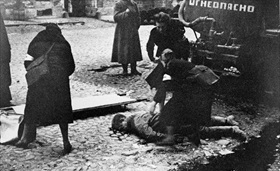 | 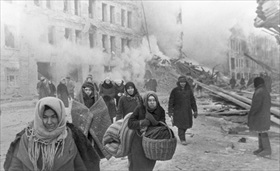 |
Left: Nurses help people wounded in the first bombardment of Leningrad, Russian Czar Peter the Great’s beautiful 18th‑century capital, September 10, 1941. Of the roughly 30,000 medical doctors and 100,000 medical nurses in prewar Leningrad, less than half survived the siege.
![]()
Right: Uprooted refugees and citizens of Leningrad leave their shelters and homes destroyed by German bombing, December 10, 1942. Between June and September 1942, Germans stationed newer and heavier artillery, including 280 mm (11‑inch) and 420 mm (17‑inch) railway guns capable of firing shells from a distance of 6–16 miles/9.7–26 kilometers into the city. They made special maps of the city for artillery bombardments that targeted city infrastructure with clinical precision, especially utilities (e.g., water supply and electrical and telecommunications grids), armament plants, businesses, warehouses, the transportation network, schools, and hospitals. Additionally, hundreds of Luftwaffe bombers dropped incendiary and high-explosive bombs on the city that added to the grotesque landscape of death, destruction, and wretchedness. During the merciless siege 3,200 residential buildings, 9,000 wooden houses, and 840 factories and plants were destroyed in Leningrad and suburbs, leaving the city a “ghost city” of thousands of ruined and abandoned buildings. The top-secret “scorched earth” plans Soviet dictator Joseph Stalin had for Leningrad, were the city to fall into enemy hands, would have produced ruinous effects similar to those brought on by the bestial round-the-clock rain of German artillery shells and bombs.
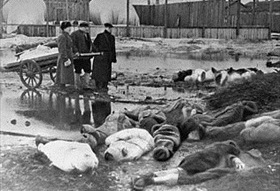 | 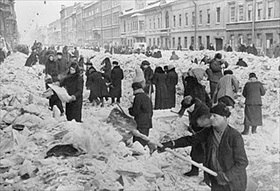 |
Left: Leningraders struggled to stay alive and defend their city in the most appalling conditions. They were bombed, shelled, starved, and frozen. They encased historic sites in sandbags, dug tank traps and trenches, built shelters and fortifications, fought fires despite water pipes being frozen, cleared rubble, tended the wounded, and, for as long as they had strength to do so, buried their dead. Many (3 percent) were killed by bombs or shells, but sadly most (97 percent) died of hunger, bitter cold (there was no heat), and disease, especially typhus. Diarrhea often proved fatal. Strict rationing was enforced: 10 ounces (283 grams) per day for workers, 5 ounces (142 grams) for everyone else with the exception of soldiers and civilian volunteers. Food sales without ration coupons were halted, sentencing thousands to death. Residents by the thousands who attempted to rest themselves by sitting on the ground couldn’t stand up again due to weakness brought on by their starved condition or disease, so they froze to death. Here three men are seen transporting victims of Leningrad’s siege to a mass grave, October 1, 1942. Not a few corpses remained unburied, piled up on streets and sidewalks and in courtyards and cellars—even in victims’ unheated apartments—until the spring thaw permitted their interment.
![]()
Right: This photo from March 8, 1942, shows mobilized citizens clearing a Leningrad street after the besieged city’s first winter, “Starvation Winter” as it became known when more than 600,000 civilians and 12,000 soldiers perished from hunger. Opposite the German siege lines Leningrad’s defenders had built a nearly impenetrable system of minefields, bunkers, trenches, dragon teeth, and antitank gun positions. For the defense of the once lovely city and the tenacity of the civilian survivors of the siege, Leningrad was the first city in the former Soviet Union to be awarded the title of Hero City in 1945.
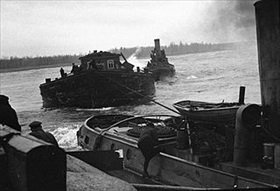 | 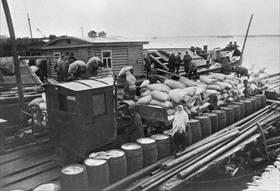 |
Left: On September 22, 1941, Hitler issued Directive No. 1a 1601/41, ordering the starvation of Leningrad’s defenders. In May 1942 the Soviets began using barges and a handful of steamers on nearby Lake Ladoga to make food deliveries to the famished survivors. The population needed 30,000 tons of food per month but the boats could not carry more than 22,000 tons. Airlifts of food did not make up the difference. In Germany little is said about the fate of wartime Leningrad. In the minds of most people, Stalingrad, Dresden, and Hiroshima are considered the largest city disasters of the Second World War. However, the cruel siege of Leningrad caused the death of about twice as many civilians as died in Germany from Allied air attacks during the entire war.
![]()
Right: Food and medicine being delivered to Leningrad by barge on Lake Ladoga, except for air the only lifeline the city had with the outside world during much of the siege, September 1, 1942. The trip by water took 16 hours each way. Total civilian death toll in the second year of the siege was about 500,000 citizens. January and February 1942 were the deadliest months of the siege; every month 130,000 civilians are found dead in Leningrad and its suburbs. Part of the civilian population was evacuated from Leningrad, although many died in the process. Some were evacuated to Siberia, where they died. Only 700,000 people were left alive out of a 3.5 million prewar population. Among them were soldiers, workers, surviving children, and women. Some 300,000 of the survivors were soldiers who came from distant parts of the country and from the country’s northern border with Nazi-aligned Finland to help defend the besieged city. Land mines left by the Germans caused thousands of deaths among returning citizens.
Siege of Leningrad, 1941–1944 (Skip first 30 seconds)
![]()

 History buffs, there is good news! The Daily Chronicles of World War II is now available as an ebook for $4.99 on Amazon.com. Containing a year’s worth of dated entries from this website, the ebook brings the story of this tumultuous era to life in a compelling, authoritative, and succinct manner. Featuring inventive navigation aids, the ebook enables readers to instantly move forward or backward by month and date to different dated entries. Simple and elegant! Click
History buffs, there is good news! The Daily Chronicles of World War II is now available as an ebook for $4.99 on Amazon.com. Containing a year’s worth of dated entries from this website, the ebook brings the story of this tumultuous era to life in a compelling, authoritative, and succinct manner. Featuring inventive navigation aids, the ebook enables readers to instantly move forward or backward by month and date to different dated entries. Simple and elegant! Click 











